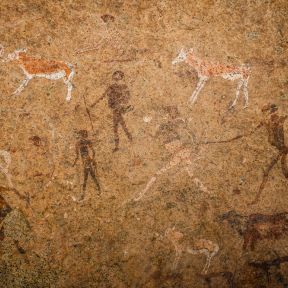DIET- Obesity as a Disease of Civilization. When it comes to being overweight, we experience the wrong sort of guilt. Reviewed by Lybi Ma

Obesity contributes to many metabolic diseases that are common in all developed countries but were largely absent in subsistence farmers. Putting on too much weight is often due to moving too little rather than eating too much.
How to Fatten Livestock: Two Key Variables Are Nutrition and Activity
Farmers used to deliberately fatten livestock prior to the sale of meat (although leaner meat is currently in vogue). How was this accomplished? The animals were kept in a small space that restricted their movement. Their nutritional intake was increased by adding attractive high-calorie foods such as cereal.

Modern life creates analogous living conditions. We spend most of our lives in sedentary pursuits such as driving, office work, and interacting with screens. Attractive high-calorie foods are sold in supermarkets and convenience stores. These foods are constantly available, encouraging us to snack around the clock.
In one experimental feeding system, rats consumed snack foods such as chocolate, salami, and cheese where the food selection was changed regularly. Not surprisingly, the rats overate and became grossly overweight. The outcome of this cafeteria feeding system depends on levels of physical activity. Rats who could run on activity wheels were better at controlling their body weight.
The relevance for modern life is that most people get so little exercise they are incapable of maintaining normal body weight. This is where the energetic features of hunter-gatherer societies are quite revealing.
Active People Consume a Lot of Food Without Gaining Weight
Sedentary populations generally eat too much, making it difficult to maintain a healthy body weight.
They are particularly vulnerable to high-calorie foods, and to snacking, which are features of modern life.
It is often assumed that being overweight is simply the result of eating too much. Yet analysis of the food intake of indigenous hunter-gatherers, such as the Ache of Paraguay, paints a very different picture.1 Corrected for body weight, the Ache consumed about twice as many calories as the average American. Yet, their obesity rate was zero, as is true for other hunter-gatherers.
How was it possible to eat so much and never gain weight? The answer is that these were highly active people who did more than the weekly recommended physical activity levels in the US every single day.
While physical activity consumes energy directly, there are numerous physiological mechanisms through which prolonged exercise prevents weight gain.2 One is the mobilization of fats that reduces feelings of hunger. Another is the increase of metabolism, or heat production, by the body.
When a person eats a meal, there is a surge in metabolism, known as the thermic effect of food. This effect is greater for people who are physically active.
There is nothing unusual about subsistence people in their response to exercise. When most Americans were farmers early in the 20th century, they likely consumed much more food than modern people based on the amount of food produced on farms. Yet, there was almost no obesity and old photographs show that farm workers were skinny as rails.
All of this suggests that activity level is a more fundamental driver of body weight than diet is for populations that are adequately nourished. Physically active populations are protected against obesity however much they eat.
Guilty Eating
Modern populations generally get far too little exercise. This shows up first in childhood obesity. In the past, children engaged in vigorous play activities outdoors that protected them from gaining too much weight. The same principle applies to young mammals that never accumulate excess fat under natural conditions.2 Children who engage with electronic screens indoors mostly get too little physical exercise. This makes them vulnerable to the problems of modern diet including too much sugar, too much fat, and snacking between meals on high-calorie foods.
For the past half-century, experiments on lab animals demonstrated that this dietary regimen conspires with physical inactivity to result in dramatic weight gain. Why has this ghastly experiment continued to play out in the human world such that childhood obesity is rising in every developed country? Unfortunately, this includes France long an exemplar of the very best diet in school cafeterias.
If physical activity level is the critical factor in maintaining a healthy body weight, why do we continue to focus exclusively on diet? The reason appears to be largely psychological.
Adults with a weight problem frequently confess to lapsing from dietary rectitude by succumbing to the appeal of an exotic dessert. Instead of doing what was right, they did something that gave them intense pleasure. This is a recipe for feeling guilty.
On the other hand, when it comes to sitting around, it is hard to feel guilty. After all, you have done nothing! What does it take to make people feel guilty about endangering their health by moving too little?
- Questions and Answers
- Opinion
- Motivational and Inspiring Story
- Technology
- Live and Let live
- Focus
- Geopolitics
- Military-Arms/Equipment
- Securitate
- Economy
- Beasts of Nations
- Machine Tools-The “Mother Industry”
- Art
- Causes
- Crafts
- Dance
- Drinks
- Film/Movie
- Fitness
- Food
- Jocuri
- Gardening
- Health
- Home
- Literature
- Music
- Networking
- Alte
- Party
- Religion
- Shopping
- Sports
- Theater
- Health and Wellness
- News
- Culture

